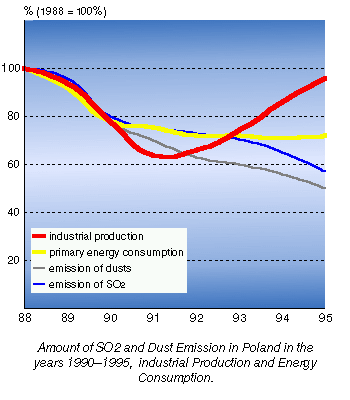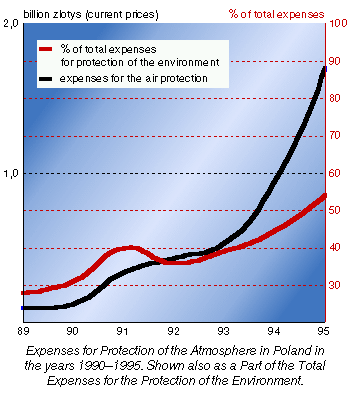Air Protection, after 1989
![]()
 The revolutionary
changes which took place in 1989 signalled the beginning of a
serious economic crisis for Poland. Upon the liquidation of the
RWPG, Poland lost its main export market. Suddenly, there was
a decrease in the demand for heavy industryís products,
thereby significantly diminishing the use of natural resources
and energy in the country. In the years 1989ñ1991, Polish
industrial production decreased by over 35% (See LEFT). It is
no surprise, that along with the decrease in industrial production,
a decrease in energy con../picption was apparent (approximately
25%), as well as a decrease in the emission of the main atmospheric
pollutants (about 25ñ33%).
The revolutionary
changes which took place in 1989 signalled the beginning of a
serious economic crisis for Poland. Upon the liquidation of the
RWPG, Poland lost its main export market. Suddenly, there was
a decrease in the demand for heavy industryís products,
thereby significantly diminishing the use of natural resources
and energy in the country. In the years 1989ñ1991, Polish
industrial production decreased by over 35% (See LEFT). It is
no surprise, that along with the decrease in industrial production,
a decrease in energy con../picption was apparent (approximately
25%), as well as a decrease in the emission of the main atmospheric
pollutants (about 25ñ33%).
Since 1992, completely opposite trends in industrial production and polluting emissions have become evident. Production, again, began to increase, in the beginning just slightly (4% in 1992). Later, the increase in production was dynamic (10% a year in 1994 and 1995). This increase in production, however, occurred alongside sTABLE energy con../picption which was approximately 27% lower than in 1989. In this time period the effectiveness of Polish energy con../picption dramatically improved and costs of production decreased, due mainly to the ineviTABLE pressure exerted on Polish production by their foreign competitors. Most of the old, ineffective factories in which much energy was wasted, were eliminated and many other factories were modernised and equipped with the newest energy saving technology, taking advantage also of the so-called ëexcessí energy. In recent years, a rapid increase in the number of energy saving initiatives have been observed in the municipal sector. These initiatives include the elimination of coal heated stoves and small ineffective broiler rooms, the thermoinsulation of buildings, and the introduction of thermostats and energy meters in centrally heated buildings. Due to these effective initiatives, Polandís economy is growing without an increase in energy con../picption. However, there is much yet to be done. In future years, the success and further development of our country will depend on cost and quality effective energy con../picption.
 Saving energy is
certainly the cheapest method of protecting our atmosphere; limiting
the amount of coal fuel used in industry and in the private sector
greatly diminishes the emission of atmospheric pollutants. It
is worth noting that 90% of SO2 and NOx,
as well as 70% of the emission of dust are a result of the burning
of fuels for energy purposes in industry, and the municipal and
transport sectors. Saving energy is also financially advantageous
to investors.
Saving energy is
certainly the cheapest method of protecting our atmosphere; limiting
the amount of coal fuel used in industry and in the private sector
greatly diminishes the emission of atmospheric pollutants. It
is worth noting that 90% of SO2 and NOx,
as well as 70% of the emission of dust are a result of the burning
of fuels for energy purposes in industry, and the municipal and
transport sectors. Saving energy is also financially advantageous
to investors.
Regardless of all the improvements mentioned, Poland still is behind in atmospheric protection. Many other measurements, besides energy conservation, need to be taken to curb air pollution.
Besides the above mentioned advantageous modifications, connected to the modernisation of industry, the building of new environmentally safe installations in certain factories and power plants, should be noted. Since 1994, increasing financial investment in installations for desulphurization of fuels, for reduction of dust emission, nitrogen oxides and other toxic substances, has been observed. More frequently, these installations represent the highest standards in the world. In Polandís two largest power plants, Belchatow and Turow, and in power plants located in Upper Silesia, Jaworzno, Rybnik, Lagiesza and Siersza, particularly noteworthy investments have been made to reduce SO2 emissions. In 1995, investments in the area of air quality protection were 4 times as much as in 1992, reaching 1.7 billion zlotys (See RIGHT). This amount constituted 54% of the total yearly investment in environmental protection in Poland. It is worthwhile to note, that in previous years, investments in air quality protection were much less significant, constituting only 35ñ40% of the total investment in environmental protection.
Despite Polandís rapid economic growth, the above mentioned modernisation of industry, the employment of energy saving technology, and direct investment in air quality control, contribute to a constant decrease in the emission of main atmospheric pollutants. As a result, the emission of SO2 and dust in 1995 were approximately 40% and 50% respectively, lower than in 1989. These accomplishments are already indicative of the goals which were made for the year 2000, in terms of air pollution, in the "Political Ecology of the Nation." This is a great success in environmental protection for Poland, which is still in the process of transforming its economy.
 An equal amount
of success, in reducing emission of gases which change the climate
of the earth, known as the "greenhouse gases", has also
been noted. Fig. 36c illustrates the emission of CO2
and other harmful gases (freon R11 and R12), in the past few years.
From the graph, it is evident that in 1994 the emission of CO2
was approximately 30% less than in 1988, which was recognised
as the base year for Poland in terms of the Global Convention
of Climate Protection. This undeniable success is directly related
to the above mentioned processes of economic modernisation and
conservation of energy. All of the figures indicate that by the
year 2010, the emission of CO2 in Poland will become
constant and 20ñ25% lower than it was in 1988. This would
be an international success for Poland.
An equal amount
of success, in reducing emission of gases which change the climate
of the earth, known as the "greenhouse gases", has also
been noted. Fig. 36c illustrates the emission of CO2
and other harmful gases (freon R11 and R12), in the past few years.
From the graph, it is evident that in 1994 the emission of CO2
was approximately 30% less than in 1988, which was recognised
as the base year for Poland in terms of the Global Convention
of Climate Protection. This undeniable success is directly related
to the above mentioned processes of economic modernisation and
conservation of energy. All of the figures indicate that by the
year 2010, the emission of CO2 in Poland will become
constant and 20ñ25% lower than it was in 1988. This would
be an international success for Poland.
Even greater success has been noted in the area of eliminating freon gases from production processes, cosmetics, and cooling equipment. In 1994, the use of the two most harmful freon gases (R11 and R12) represented only 16.5% of the total emission of these gases in 1988. Further improvements were made in the following two years and it is safe to say that today the use of freon gases has been almost entirely eliminated in our country (according to the Convention on Ozone Protection, which Poland ratified). However, the problem of eliminating freon from old, ineffective cooling equipment when it is repaired or replaced, remains unsolved. Within the next two years, a system to recover freon from the above mentioned archaic equipment, will be organised on a national level.
There exists a sector, however, where in the last few years, a significant increase in emission of main atmospheric pollutants has occurred ñ the transport sector. After 1989, an unusually dynamic rise in the number of cars, especially personal automobiles, was observed (GRAPH illustrating Amount of Lead Emitted by the Transport Sector). In the years 1989ñ1995 the amount of personal automobiles skyrocketed by approximately 70%, while the number of trucks increased by approximately 40%. It is no surprise that with the rise in the number of cars, the amount of CO2, NOx, and even hydrocarbons must increase, if most of the cars are old, inexpensive and not equipped with environmentally safe technology. The only noteworthy success of the transport sector, in the recent past, was the introduction of unleaded gasoline. The emission of lead in the years 1990ñ1994 decreased by 67% and is constantly continuing to decrease. However, in the near future, an increase in NOx, CO and black smoke emission from the transport sector can be expected, although the introduction of catalysers and fuel burning substances should level this trend.
In conclusion, Polandís entrance to the market economy in 1989 enabled many mechanisms which were beneficial to environmental protection and thus, also to atmospheric protection. Due to the many measurements taken to decrease air pollution in industry, it has decreased by 30ñ50% and is constantly on the decline. Industry continues to be less of a contributor to air pollution, while the transport sector seems to be contributing the most, this being particularly true in large cities and on major roadways. Stimulation of political activity in the area of energy conservation also continues to be of critical importance.